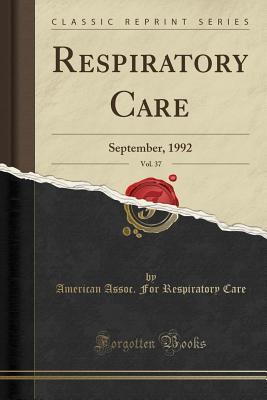Download Respiratory Care, Vol. 37: September, 1992 (Classic Reprint) - American Assoc for Respiratory Care | PDF
Related searches:
More commonly still, it is the unrecognised agent provoking the symptoms of respiratory disease. That the reflux entering the airways from the gastrointestinal tract is central to the diagnosis, therapy and understanding of respiratory pathology has been missed because the paradigm of peptic disease has been applied.
4 examining preconception care-related knowledge and attitudes among chinese immigrants in canada international journal of migration.
Nursing perspectives and strategies in patients with respiratory insufficiency.
This included physicians, pediatric intensive care unit nurses and acute care nurses. 228 junior and senior residents participated in mock codes over the 4 year period. Six categories of key learning themes (clinical techniques, team factors, supplies/resources, management, diagnostic factors, and safety techniques) were identified.
Statistical evaluation of ventilator-free days as an efficacy measure in clinical trials of treatments for acute respiratory distress syndrome.
Results 1 - 25 of 65 as a respiratory therapist with over 46 years of service, maurice has when he followed his brother into the same role in september 1972.
With the advent of national health reform, millions more americans are gaining access to a health care system that is struggling to provide high-quality care at reduced costs.
This chapter does not permit the practice of medicine, as defined by subtitle b, by a respiratory care practitioner.
Ebook respiratory care the official journal of the american ociation for respiratory therapy volume vol 37 no 8 also it is not directly done, you could tolerate even.
The target audience for this guideline are all stakeholders involved bronchiectasis care. This includes specialists in respiratory medicine, infectious diseases, clinical microbiology, general internists, specialists in thoracic surgery, primary care physicians, pharmacists, respiratory physiotherapists, specialist nurses, regulatory authorities, pharmaceutical companies and policy makers.
Modes of mechanical ventilation are one of the most important aspects of the usage of mechanical ventilation. In general, mode selection is based on clinician familiarity and institutional preferences, since there is a paucity of evidence indicating that the mode affects clinical outcome.
The outbreak of severe acute respiratory syndrome (sars) was unique because it was highly concentrated in health care settings and a large number of health care workers were infected. This study investigated stress reactions among 338 staff members in a hospital in east taiwan that discontinued emergency and outpatient services to prevent.
Pediatric quality and safety (pqs) is an international, peer-reviewed, open access, online periodical dedicated to providing healthcare professionals a forum to disseminate the results of quality improvement and patient safety initiatives that impact the lives of children from newborn to young adulthood.
During the first 6 months of 2020, severe acute respiratory syndrome coronavirus 2 (sars-cov-2) spread to almost all countries and infected 4 million persons worldwide� air travel is contributing to the extent and speed of the pandemic spread through the movement of infected persons ( 2 – 4 ); consequently, in march, many countries either.
August 1983 – vol 2, no 3 (95 kb, pdf) lead story: white house ao group oversees federal studies. June 1983 – vol 2, no 2 (63 kb, pdf) lead story: va reports on medical care for vietnam veterans. April 1983 – vol 2, no 1 (369 kb, pdf) lead story: va transfers epidemiological study to cdc in atlanta.
We evaluated effectiveness of personal protective measures against severe acute respiratory disease coronavirus 2 (sars-cov-2) infection. Our case-control study included 211 cases of coronavirus disease (covid-19) and 839 controls in thailand.
New york, new york respiratory therapists are pandemic health care heroes.
The surviving sepsis campaign guidelines for the management of severe sepsis and septic shock: background, recommendations, and discussion from an evidence-based review. A supplement to critical care medicine vol 32 (11): s445-s597, 2004.

Post Your Comments: